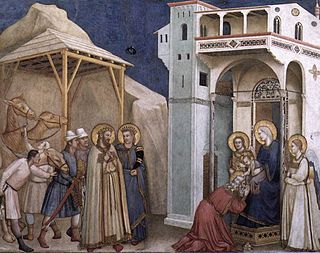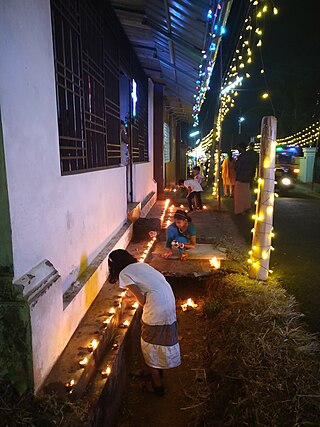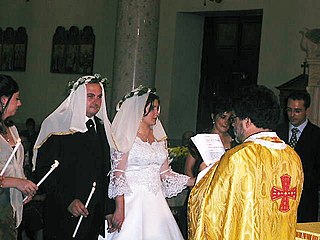Related Research Articles

The liturgical year, also called the church year, Christian year or kalendar, consists of the cycle of liturgical seasons in Christian churches that determines when feast days, including celebrations of saints, are to be observed, and which portions of Scripture are to be read either in an annual cycle or in a cycle of several years.
In the liturgical calendar of the Roman Rite, a solemnity is a feast day of the highest rank celebrating a mystery of faith such as the Trinity, an event in the life of Jesus, his mother Mary, his earthly father Joseph, or another important saint. The observance begins with the vigil on the evening before the actual date of the feast. Unlike feast days of the rank of feast or those of the rank of memorial, solemnities replace the celebration of Sundays outside Advent, Lent, and Easter.

The Twelve Days of Christmas, also known as Twelvetide, is a festive Christian season celebrating the Nativity of Jesus. In some Western ecclesiastical traditions, "Christmas Day" is considered the "First Day of Christmas" and the Twelve Days are 25 December to 5 January, inclusive, with 6 January being a "thirteenth day" in some traditions and languages. However, 6 January is sometimes considered Twelfth Day/Twelfth Night with the Twelve Days "of" Christmas actually after Christmas Day from 26 December to 6 January. For many Christian denominations—for example, the Anglican Communion and Lutheran Church—the Twelve Days are identical to Christmastide, but for others, e.g. the Roman Catholic Church, Christmastide lasts longer than the Twelve Days of Christmas but the Christmas itself lasts one day on December 25.

The Syro-Malankara Catholic Church, also known as the Malankara Syrian Catholic Church, is an Eastern Catholic sui iuris particular church in full communion with the worldwide Catholic Church possessing self-governance under the Code of Canons of the Eastern Churches. It is one of the major archiepiscopal churches of the Catholic Church. It is headed by Major Archbishop Baselios Cardinal Cleemis Catholicos of the Major Archdiocese of Trivandrum based in Kerala, India.

The Syro-Malabar Catholic Church is an Eastern Catholic church based in Kerala, India. The Syro-Malabar Church is an autonomous particular church in full communion with the pope and the worldwide Catholic Church, including the Latin Church and the 22 other Eastern Catholic churches, with self-governance under the Code of Canons of the Eastern Churches (CCEO). The Church is headed by the Major Archbishop of the Syro-Malabar, currently George Alencherry. The Syro-Malabar Synod of Bishops canonically convoked and presided over by the Major Archbishop constitutes the supreme authority of the Church. The Major Archiepiscopal Curia of the Church is based in Kakkanad, Kochi. Syro-Malabar is a prefix reflecting the church's use of the East Syriac Rite liturgy and origins in Malabar. The name has been in usage in official Vatican documents since the nineteenth century.

Epiphany, also known as "Theophany" in Eastern Christian tradition, is a Christian feast day commemorating the visit of the Magi, the baptism of Jesus, and the wedding at Cana.

The Holy Qurbana, refers to the Eucharistic liturgy as celebrated in East Syriac Christianity and the liturgical books containing the rubrics for its celebration. Churches that celebrate this liturgy include various descendants of the Church of the East. East Syriac Christianity consists of an Edessan liturgical rite called the East Syriac Rite. The major anaphora of the East Syriac tradition is the Holy Qurbana of Saints Addai and Mari; Addai being a disciple of Thomas the Apostle and Mari being Addai's disciple. These churches are primarily based in the Middle East and India, with diasporic communities settled in the western world.

The Epiphany season, also known as Epiphanytide or the time of Sundays After Epiphany, is a liturgical period, celebrated by many Christian Churches, which immediately follows the Christmas season. It begins on Epiphany Day, and ends at various points as defined by those denominations. The typical liturgical color for the day of Epiphany is white, and the typical color for Epiphany season is green.

The West Syriac Rite, also called the Syro-Antiochian Rite and the West Syrian Rite, is an Eastern Christian liturgical rite that employs the Divine Liturgy of Saint James in the West Syriac dialect. It is practised in the Maronite Church, the Syriac Orthodox Church, the Syriac Catholic Church and various Malankara Churches of India. It is one of two main liturgical rites of Syriac Christianity, the other being the East Syriac Rite.

The East Syriac Rite or East Syrian Rite, also called the Edessan Rite, Assyrian Rite, Persian Rite, Chaldean Rite, Nestorian Rite, Babylonian Rite or Syro-Oriental Rite, is an Eastern Christian liturgical rite that employs the Divine Liturgy of Saints Addai and Mari and the East Syriac dialect as its liturgical language. It is one of two main liturgical rites of Syriac Christianity, the other being the West Syriac Rite.

Pindikuthi Perunnal or Rakkuli Perunnal is a traditional and important festival of Saint Thomas Christians celebrated on 6 January. Pindikuthi Perunnal is the Saint Thomas Christian counterpart of Denha in Eastern church and Epiphany in Western Church. The liturgical season Denha Kaalam begins with the Sunday nearest to Pindikuthi Perunnal.
The Fifth Sunday of Easter is the Sunday four weeks after the Christian celebration of Easter. In Western Christianity, this day is also known as the Fourth Sunday after Easter or Cantate Sunday. Eastern Christianity also calls this day the "Fifth Sunday," but typically using an Eastern synonym for Easter; for example, Fifth Sunday of Holy Pascha or Fifth Sunday of the Resurrection. In the Byzantine Rite, this day is also known as the Sunday of the Samaritan Woman.
Marian feast days in the liturgical year are celebrated in honour of the Blessed Virgin Mary. The number of Marian feasts celebrated, their names can vary among Christian denominations.
The Syro-Malabar Church is a Catholic Church sui iuris of the East Syriac Rite that adheres to the following calendar for the church's liturgical year. Like other liturgical calendars, the Syro-Malabar calendar loosely follows the sequence of pivotal events in the life of Jesus.

Ramsha is the Aramaic and East Syriac Rite term for the evening Christian liturgy followed as a part of the seven canonical hours or Divine Office, roughly equivalent to Vespers in Western Christianity. It's also called Ramsho in the West Syriac Rite. It is used in the Syriac churches of the East Syriac tradition, including the Assyrian Church of the East of Iraq, the Ancient Church of the East of Iraq, the East Syriac Saint Thomas Christians of the Malabar coast, Kerala, India, and the Chaldean Catholic Church of Iraq. The Chaldean Catholic and Syro-Malabar Churches are all Eastern Catholic churches in full communion with the Catholic Church.
The Season of Apostles is a liturgical season in East Syriac Christianity. The season begins with the feast of Pentecost and continues for seven weeks. It is followed by the Season of Summer.

Pentecost season, also known Pentecostide, as well as the time of Sundays after Pentecost or Sundays after Trinity, is a liturgical period, celebrated by some Christian churches, which immediately follows the Easter season. Although the start and end dates vary by liturgical tradition, the season typically begins on the day of Pentecost and continues throughout the rest of the liturgical year, ending just before the season of Advent. The liturgical color for this period is typically green or red.

The Holy Qurobo or Holy Qurbono refers to the Eucharist as celebrated in Syro-Antiochene Rite and the liturgical books containing rubrics for its celebration. West Syriac Rite includes various descendants of the Oriental Orthodox and Eastern Catholic churches. It consists of two distinct liturgical traditions: the Maronite Rite, and the Jacobite Rite. The major Anaphora of both the traditions is the Divine Liturgy of Saint James in Syriac language. The Churches are primarily based in the Middle East, Africa, and India.
The Eastern Catholic Churches of the Catholic Church utilize liturgies originating in Eastern Christianity, distinguishing them from the majority of Catholic liturgies which are celebrated according to the Latin liturgical rites of the Latin Church. While some of these sui iuris churches are of the same liturgical ritual families as other Eastern Catholic churches and Eastern churches not in full communion with Rome, each church retains the right to institute its own canonical norms, liturgical books, and practices for the ritual celebration of the Eucharist, other sacraments, and canonical hours.

The Mystery of Crowning is a ritual component of the sacrament of marriage in Eastern Christianity. Variations of the crowning ceremony exist in multiple liturgical rites, including the Byzantine, Coptic, West Syriac, and East Syriac Rites of the Eastern Orthodox, Oriental Orthodox, and Eastern Catholic Churches. The crowning ceremony typically features a crown being placed upon the head of both the bride and bridegroom, crowning them as the queen and king of a new family.
References
- 1 2 Moolan, John (1985). The Period of Annunciation–Nativity in the East Syrian Calendar: Its Background and Place in the Liturgical Year. Vadavathoor, Kottayam: Pontifical Oriental Institute of Religious Studies. p. 13.
- ↑ "Syro Malabar Liturgical Seasons". Syro-Malabar Church Internet Mission.
Liturgical seasons of the year are Annunciation, Epiphany, Great Fast, Resurrection, Apostles, Summer, Eliyah-Sliba, Moses, and Dedication of the Church
- ↑ Madhavathu, Maryann (2016). Liturgy as a Sacrament of the Paschal Mystery: A Study of the Theological Relations between the Liturgy of the Eucharist and the Liturgy of the Hours in the Roman and Syro-Malabar Rites (PDF) (Thesis). Katholieke Universiteit Leuven. p. 6.
- ↑ Syro-Malabar Major Archiepiscopal Commission for Liturgy. "Syro-Malabar Liturgical Calendar: 2020–2021" (PDF). p. 6.
The liturgical year of the Syro-Malabar Church begins with the period of Annunciation. The four weeks in preparation for the feast of the Nativity of Jesus celebrated on 25th December, constitute this season.
- ↑ "The Sacred Lectionary 2020–2021" (PDF). The Major Archiepiscopal Curia of the Syro-Malankara Catholic Church. 2020. p. 26.
- ↑ Sadler Butler, Joanne (December 22, 2016). "A Merry Maronite Christmas". The Wanderer .